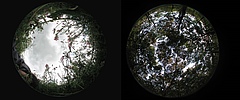Better, worse, or both? The temporal paradox of diverse plant communities

Grassland and forest biodiversity experiments: grassland experiment from the Jena Biodiversity experiment (Germany, left) and forest experiment from the Sardinilla Experiment (Panama, right). Photos: Anja Vogel (FSU Jena) & Nathaly R. Guerrero-Ramírez (iDiv/ Leipzig University)
Note for the media: Use of the pictures provided by iDiv is permitted for reports related to this media release only, and under the condition that credit is given to the picture originator.
Imagine for a moment that your favorite football team is becoming better year after year and is now heads and shoulders above other teams. Your team’s success can be the result of the good performance of your team, the bad performance of the other teams or both things happening at the same time. Now, let’s steer away from football and return to plant communities. Evidence suggests that high diversity plant communities are doing better year after year, breaking away from low diversity communities (in terms of their biomass production). This can be the result of how well high diversity communities are doing, that low diversity communities are doing worse, or both.
An international team of researchers used 26 long-term grassland and forest experimental ecosystems to understand how biodiversity effects change over time. These include, among others, the Jena Experiment and the Kreinitz Tree Diversity Experiment – two iDiv research platforms. The results of this study are published in
Nature Ecology & Evolution.
“We wanted to determine if the increase of biodiversity effect on biomass production is the result of high diversity communities doing better, low diversity communities doing worse or both. Moreover, we wanted to know if the trend underlying temporal changes was constant between ecosystems and among sites”, said Nathaly Guerrero-Ramírez a doctoral researcher from the German Centre for Integrative Biodiversity Research in Leipzig (iDiv).
The authors found that the increase in biodiversity effects in grasslands experiments can result in either high diversity communities doing well, low diversity communities doing worse, or both. Interestingly, soil conditions affected which trend underlies the increase in biodiversity effects, making some areas more susceptible to a decrease in biomass production over time. In contrast, high diversity forest communities are better from the beginning, accumulating more and more biomass through time.
“Low diversity communities are a big part of our productive landscapes, for example crops and tree plantations. Thus, a decrease in the function of low diversity communities over time can have multiple implications for the provisioning of vital ecosystem services. We consider that management practices that reinforce diversity, either by having multiple plant species at the same time or varying plant species over time, can contribute to attenuate the decrease or increase biomass production”, said Nathaly.
Elena Motivans and Nathaly R. Guerrero-RamírezPublication:Nathaly R. Guerrero-Ramírez,
Dylan Craven,
Peter B. Reich,
John J. Ewel,
Forest Isbell,
Julia Koricheva,
John A. Parrotta,
Harald Auge,
Heather E. Erickson,
David I. Forrester,
Andy Hector,
Jasmin Joshi,
Florencia Montagnini,
Cecilia Palmborg,
Daniel Piotto,
Catherine Potvin,
Christiane Roscher,
Jasper van Ruijven,
David Tilman,
Brian Wilsey &
Nico Eisenhauer (2017): Diversity-dependent temporal divergence of ecosystem functioning in experimental ecosystems. Nature Ecology and Evolution. doi:10.1038/s41559-017-0325-1
http://rdcu.be/wnNIhttp://dx.doi.org/10.1038/s41559-017-0325-1Links:
Behind the paper - a blog post in NEE:
https://natureecoevocommunity.nature.com/users/65001-nathaly-guerrero-ramirez/posts/20842-better-worse-or-both-the-temporal-paradox-of-diverse-plant-communitiesContact:Nathaly R. Guerrero-Ramírez
Research Group “Experimental Interaction Ecology”
German Centre for Integrative Biodiversity Research & Leipzig University
Phone: +49 341 9733174
Web:
https://www.idiv.de/groups_and_people/employees/details/eshow/guerrero_ramirez_nathaly_rokssana.htmlDylan Craven
Research Group “Spatial Interaction Ecology”
German Centre for Integrative Biodiversity Research & Helmholtz Centre for Environmental Research
Phone: +49 341 9733117
Web:
http://dylancraven.weebly.com/Prof. Nico Eisenhauer
Head of Research Group “Experimental Interaction Ecology”
German Centre for Integrative Biodiversity Research & Leipzig University
Phone: +49 341 9733167
Web:
https://www.idiv.de/en/groups_and_people/employees/details/eshow/eisenhauer_nico.html
